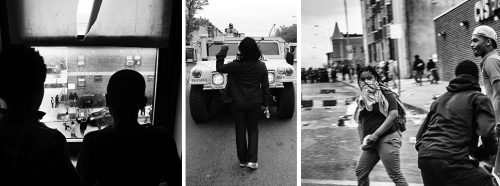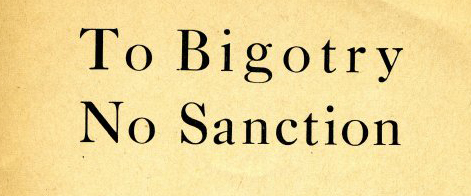Responding to this moment

A blog post by Deputy Director Tracie Guy-Decker. Read more posts from Tracie by clicking HERE.
When JMM staff approached me about moderating one of the two conversations we had planned to accompany our now-virtual exhibit, GrayinBlackandWhite.com, I didn’t hesitate to say “yes.” Those who know me well know the #BaltimoreUprising that followed the death of Freddie Gray in police custody five years ago was a touchstone on my personal antiracism journey. I was glad to be able to lend my voice and presence to a conversation marking the fifth anniversary of a time that was so important to my understanding of the world and my role in it. Two weeks later, on May 21, 2020, I was again pleased to play a role in another conversation, this time with female activists and journalists working to expose and address the root causes of the Uprising.

My answer was two-fold: First, at JMM, we regularly assert that Maryland Jewish history is Maryland history, and since we make that assertion, we must value and amplify its corollary: Maryland African American History is Maryland History. And second, at JMM, we know that the Jewish community of Maryland is diverse and multi-ethnic. When most of us think of American Jews, we imagine white-skinned Ashkenazi Jews. And, though there are a lot of us, (I am one) the Jewish community is made up of white, black, and brown people. Which means that institutional and structural racism, the root causes of the Baltimore Uprising, are Jewish issues.

His name was George Floyd. The whole world has watched the cruel treatment Mr. Floyd received at the hands of men who wore a uniform issued by a city government. The world watched, and we were horrified, outraged, saddened, terrified, sickened. (The exact emotional response changes depending on the person reacting and the moment.) Protests in response to Mr. Floyd’s death have sprung up around the country—indeed, around the world. Many have turned violent, though there is evidence at least some of the violence is caused by saboteurs, not protestors. In Baltimore, we can’t help but see parallels with what happened here five years ago. To be frank, it’s disheartening. It’s disheartening that so little has changed in these five years, that the pain and anger and heartache is happening again.
But there is also reason for hope. I am noticing many more of my fellow white-skinned Americans paying attention to questions of race and racism than I have in my memory. As I write this, the top three books on Amazon’s best seller list are White Fragility: Why It’s So Hard for White People to Talk about Racism, So You Want to Talk about Race, and We’re Different, We’re the Same (a kids’ book about race). In my opinion, this is a great sign. As Marvin said in his statement from the Museum on George Floyd’s death and the ongoing protests, “We must educate ourselves. We must listen, truly listen, to the voices of people who don’t look or live or worship as we do. We must commit to being upstanders, not bystanders. We will only change the story if we change ourselves.”
I want to urge us all to be steadfast. We cannot let this impulse to learn more and to move toward antiracism be a trend we abandon as quickly as we picked it up. I believe this work to be among the most important work we can do if we want to leave our children a better world. To that end, I want to offer a thought experiment, especially to my fellow Jews who may be reading this.
When I want to better understand a situation, I often find it helpful to find a parallel that is closer to me—a situation with which I am more familiar that is somehow similar to the one I seek to understand. I want to offer you a parallel for this moment: imagine what it would look like, what it would feel like if men and women wearing uniforms issued by a governmental agency were disproportionately killing unarmed Jews with little to no consequences. Imagine it happening over and over and over and over again. Imagine complaining about it, protesting it, alerting your non-Jewish neighbors in various ways for generations, and not being believed by the majority who distrust you and think you must be lying because you don’t worship as they do. “You must have done something to deserve it,” they say, and go back to their lives.

Stay with me.
Imagine in this reality that however you protest the frequent and seemingly indiscriminate killing of unarmed Jews, you’re told it’s the wrong way to protest. You’re criticized when Jewish athletes use their platform to protest. You’re criticized when you peacefully march in the street. You’re criticized when you dare say, “Jewish lives matter.” Imagine after generations of this, some people at a protest are so frustrated at never being heard, they lose control of their anger and destroy property. Others take advantage of the moment of chaos, and loot or steal. Now your non-Jewish neighbors call you names. They tell you in direct and indirect ways, the fact that your sons and daughters keep getting killed is much less important than the fact that some who participated in protests of those killings caused property damage.
This is not some dystopian future I’m describing. It’s the reality your black and brown friends, neighbors, loved ones, and at least 12 to 15% of our fellow Jews, are living right now, in 2020. I invite you to sit with that for a moment. Really sit with it. Now ask yourself, if the roles were different, if it really were Jews’ deaths being protested, what would you want your non-Jewish neighbors to do about it?

*Pictured: (Left) Broadside, directive for a “Mr. Lynch” to leave the 9th ward in 30 days or else be “visited” by a group of 300 men. “The White Caps” will take the law into their own hands. “Beware! Beware!” printed across bottom, May 7, 1889. Possibly directed against a Bacharach who ran for public office. JMM 1991.147.39. (Center) Sign stating pool for approved gentiles only at the Meadowbrook Swimming Club. JMM 1995.201.2. (Right) Cartoon from “Puck” magazine regarding hotel discrimination and Jews. JMM 1991.147.38.
**Pictured: Title from 1941 pamphlet produced by the Philadelphia Anti-Defamation Council and the American Jewish Committee. To Bigotry No Sanction: A Documented Analysis of Anti-Semitic Propaganda. JMM 1988.211.32.
